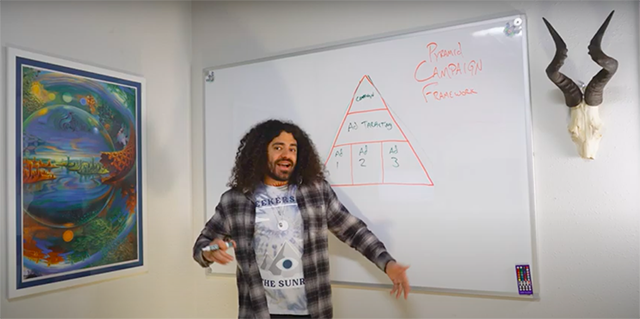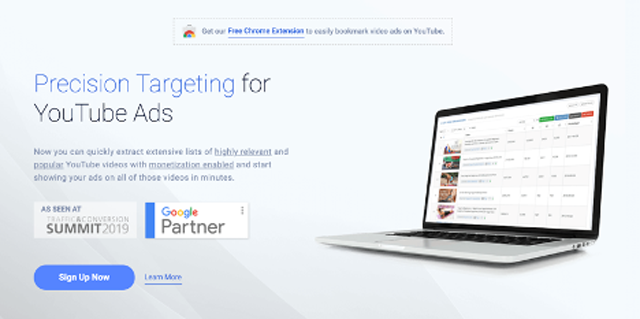 Membership TodaySign Up Now
Membership TodaySign Up NowVideo transcript
Pyramid campaign framework
Justin Sardi: Everybody loves a good pyramid scheme. Today I’m going to be explaining our pyramid campaign framework. Now people are always asking us, how do we set up our campaigns? What’s the best way to structure these campaigns so that we get the most out of them and we’re able to effectively test different audiences, ads, all that good stuff? It comes down to my pyramid scheme framework. It’s not actually a scheme, but my pyramid campaign framework, and I’m going to be breaking that down today. So let’s go ahead and dive right in.
Justin Sardi, here. CEO and co-founder of TubeSift.com and VideoAdVault.com. Today I’m going to be breaking down the pyramid campaign framework. Now people are always asking us, what is the best way to structure these campaigns so I can test different audiences, different ads, they’re not competing against each other, and I can figure out exactly what’s working the best? Now the best way to do that is with the pyramid campaign framework.
Now I’m going to start from the top and break down exactly what you need to know. I always like to start with one campaign right campaign. So we have one specific campaign. Now I like to think of the campaign as the overall containers. That campaign’s going to house all of these things, which the next one is the ad targeting. Now technically, that targeting is actually your ad group. So in a campaign, you can have multiple ad groups. But what I like to do is make my campaign essentially my ad group. So it’s the one and the one, right? So we have one campaign, one type of targeting; and then under there, I’m going to have one, two, three ads. So, ad one, ad two, ad three.

Break down your video campaign
Now I just shot a post right before this explaining how we use the three-part six minute ads framework and essentially in that post, and I’ll actually link to that below this post as well, but I talk about how you can have one ad that essentially turns into three ads. The way to do that is by having three different hooks. Now, if you want to check out that full framework post to figure out how to get those three ads going, quickly and easily, the three things that you have to have in every single one of those, definitely check that post out. It’s called the six-minute ads framework. I actually have worksheets, all that good stuff that you can have there.
But this is how I like to break down our campaigns using the pyramid campaign framework. Essentially, like I said, it’s one campaign, one ad targeting group, and three different ads. Essentially what this is going to let you do is you have one campaign, which essentially, let’s say, it’s generating leads for the TubeSift webinar, for example. So then, I might test my ad targeting. What this essentially allows me to do is I set everything up with the campaign ad targeting my three ads. Now, my first ad targeting might be placements. So I can set up the placement targeting right there, and then I set up ad one, two and three.
Now when I want to test additional audiences, so it’s not competing against the same audience, essentially what’s going to happen is first of all, with just placement targeting, Google’s going to allow me to test ad one, two and three, and it’s going to figure out which ad is working the best. It’s going to shift all the budget to, let’s say, ad three is working. We can also look at that on our own analytics and really figure out, “Okay, ad three is getting the best click through rate. Also, the better conversions.” All that kind of stuff. We’ll know, hey, whatever ad it is is converting better. So that’s going to give us data on this one targeting group.

Custom intent audience
Now with these three ads, they might not always be the same. These three ads might … placements might convert best with ad three, whereas maybe interest targeting or retargeting, if I’m doing retargeting ads, those might convert better for ad number one. Maybe that resonates better with the specific audience for retargeting. The reason I like to do this one campaign, one ad targeting, and three ad groups is because it allows me to test a number of different audiences while, keeping my ads consistent. Then I can figure out which types of audiences are resonating with which ad. I’m not having to shoot a bunch of different ads for every single targeting group.
Now, when it comes time to duplicating this campaign, I can then duplicate the campaign, which duplicates all of this, the ad targeting and all three ads. You can also add more ads, but I usually like to test three per ad group. And, dope.
Now you can test multiple ads, but I usually like to test three per ad group. It seems to be a good number. You throw as many as you want in there, or as few. But I like to say, you should at least have three of them and essentially test three different hooks because certain things are going to resonate with different audiences. But like I said, when it comes time to test different audiences, you duplicate the entire campaign and then you just go and delete your old targeting and you add your new targeting, which might be custom intent. Custom intent audience. So then, we could swap out all of these different targeting options and essentially take these three ads, same campaign, they all have the same goal, and we can spread them out. They start to multiply. This essentially would be, if we … through to the fourth power. We can then have all of this with four different audiences and we can set this up quickly, easily. Essentially setting everything up this way allows us to test multiple audiences, figure out which types of audiences are working the best, which ones maybe aren’t working.
Then also, you’ll start to see a pattern and you’ll see, hey, maybe ad two is converting better for all of these audiences. Then when it comes time to scale, all you have to do is set up a campaign with the best ad, the best audience, and boom, you are off to the races. So that is how we structure our campaigns using the pyramid campaign framework. This works extremely well. Like I said, there’s tons of different targeting options as well as three specific things that you need to have in every single one of your ads.

Partner with the best tools for your campaigns
I will link to these six-minute ads framework below this video, as well as the different targeting options video that we have. You can find all of those on our blog. We have tons of relevant information. Now, as far as targeting goes, if you don’t have TubeSift, definitely check out TubeSift. It’ll help you precision target your ads and essentially take all of these ads and put them in front of the exact people that want your product or service at the exact moment they’re searching for what you have to offer. So, really cool stuff.
Then if you want to learn more about what types of ads are converting in your niche, you can always check out VideoAdVault.com and you’ll be able to find the highest converting ads based on landing page, niche, YouTube channel that are running from all kinds of good stuff. I’ll link to that below this video as well.
So that’s all I’ve got for the pyramid scheme campaign framework. It’s not actually a scheme, but like I said, this is how we set up all our ads. So I would encourage you to set up your ads like this. I guarantee that it will allow you to test faster and get better results from your current YouTube ad efforts.
I’d love to hear your feedback. You can join our Facebook group. Let me know what you thought of this pyramid campaign framework. I hope to see you inside of Video Ad Vault and TubeSift.com. That’s it for me. Bye for now.
 Membership TodaySign Up Now
Membership TodaySign Up Now


Comments are closed.